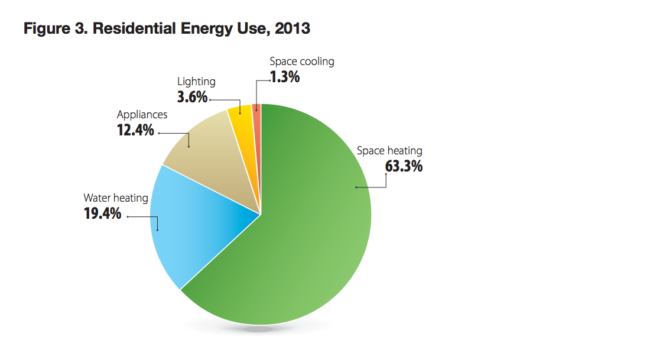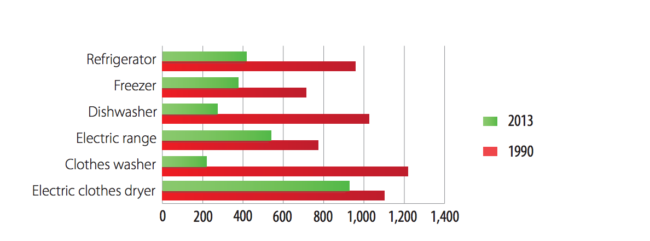In our recent post, we discussed the big upgrades and renovations you can make as a homeowner to make your house more energy efficient and save money on energy bills. Partially through writing that post and partially because of the conversations that followed, one thing became evident: efficiency and energy savings are as much about the human factor as they are about the products that go into your home. Another thing that is true: you don’t always need to undertake a big renovation to improve the energy efficiency and lower those costs. There are plenty of smaller, cheaper fixes that along with your conscious habits can significantly cut your energy bill. With this in mind, we thought we would go through some of these smaller upgrades so you can decide which ones will work best in your home and start implementing them in areas where you are spending more than you should.
The government of Canada also offers a plethora of excellent resources about making your home more energy efficient, and advice on what to be aware of, on their
Exclusive to Alberta Homeowners! Starting April 28th, 2017 Energy Efficiency Alberta provides Albertans with NEW Energy Efficiency Program that lets you SAVE up to $1500 on window replacement.
Apply For Windows Replacement Rebate Today
How to reduce your electricity bills?
You usually have one of several options when it comes to reducing energy spending in different areas of your home. You could try to change your habits and use the appliance or building product more sparingly, you could attempt to fix it or add upgrades to make it more energy efficient, or you could replace it with a newer more energy efficient appliance or building product. Each of these solutions works best in different scenarios, but you may also find that replacing or upgrading something doesn’t reduce your energy bills unless you change your energy usage habits.

Consider Assessing Your Home’s Efficiency
It’s easy to notice when you’re paying more than you should be for energy costs. It’s not always as easy to figure out exactly what is causing an increase in electricity usage. We often talk about your home as a system where many components rely on each other to keep the whole thing operating efficiently. In this context, fixing or replacing one thing may not be a sufficient solution, worse yet, it may expose problems elsewhere. And unless you are a professional contractor or home inspector, you may simply find yourself overwhelmed trying to figure out where to begin, and what energy drainers in your home require the most attention.
We often see this scenario when talking to prospective clients: homeowners notice leaks or rotten wood around their windows and decide to replace them, only to find out that all along the problem was with a leaky roof that was allowing water to run down the inside of the wall. Of course, replacing the windows in this situation is part of the solution, but it doesn’t fix the problem at the root.
And because most people are not renovation or construction experts, one thing you should consider before undertaking any serious or major projects is getting a proper energy efficiency assessment in your home to pinpoint the areas of biggest concern. Natural Resources Canada recommends a Natural Resources Canada website.
After your home has been assessed, there is a good chance the service professional will recommend one or several of these proven ways to reduce your energy bills.
How To Reduce “Space Heating” Energy Use:
Invest In A Programmable Thermostat
As you can see from the chart above, space heating amounts for roughly 63% of an average home’s energy use. Just like your electronics and appliances don’t need to be running while you are not at home, your furnace doesn’t really need to be heating or cooling your home while you’re not there. Enter programmable thermostats. The main benefit of a programmable thermostat is that they can be preset to turn on and off at different times so you aren’t continuously heating your home throughout the night or during the day while you are at work. Depending on the size of the home, heating it for just an hour prior to you coming home may make the temperature comfortable by the time you arrive. Modern thermostats are also great not only because they can program the furnace; the apps that come with these devices are great for monitoring your heating and cooling energy usage over time and can help you figure out the ideal climate conditions for your home.
Some of the most popular thermostats on the market today include Nest, Ecobee, and Honeywell. The Ecobee3 is one of our favorite options because it comes with multiple sensors that can be installed all over your house so you get a more complete and accurate picture of energy use and temperature in every room as opposed to just the whole house.
Programmable thermostats are currently in that unique space between traditional and “smart” home technology. While their effectiveness is somewhat debated because many homeowners simply don’t bother to program them, for a homeowner that is focused on lowering their energy spending. The upfront investment into one of these thermostats can also be reduced because there are often rebates from different provincial governments for homes that invest in this smart technology.
Seal and insulate air ducts
We previously talked about the benefits of upgrading to an energy-efficient furnace. Another efficiency improvement you can undertake here has to do with how efficiently warm or cool air is being distributed around your home.
Most homes rely on a system of ducts to deliver air at a desired temperature to different rooms. Because the ducts themselves are a material that can conduct heat, it is always assumed that some heat will be lost to the surrounding ducts. Furthermore, over time ducts can separate and have areas where air can escape out of the duct. This negatively affects the efficiency of your home because not all the air gets to where it needs to go, meaning your furnace has to work harder, resulting in higher bills. Re-sealing your ducts is the first step to ensuring little to no leaks. But if you want to take it a step further, or you have an older duct system, consider insulating your ducts. This is a job that can be done professionally, but also yourself with insulating materials from a hardware store. The video below explains a little about how ducts work and demonstrate some techniques on how to effectively insulate them.
If your home has rectangular shaped ducts, check out the video below for two different methods of insulating them:
If your vents are sealed and insulated properly, your furnace will be able to distribute heat throughout your home more evenly, without working overtime to keep the home warm.
Replace Furnace Filter Regularly
Once your ducts are all sealed and insulated, you will want to make sure your furnace performs at its best. Whether you are upgrading to a new furnace, or just trying to get the most out of your existing one, having a clean air filter is essential to maximum air distribution, not to mention your health. It is recommended that you replace your furnace air filter every 1-3 month depending on the age of the furnace, and the filter’s state. Check out this video about how to replace a furnace filter in your home:
CONSUMER BEWARE: Air Duct Scams
Because so much of your energy bill is associated with heating your home and centers around the furnace and ducts, the heating supply in your home is one of the more popular retrofit projects. Unfortunately, it is also one industry where there is a lot of lies and misconceptions being fed to unsuspecting homeowners. Partially because you can’t see all the way inside the ducts, it is often hard to figure out exactly what got cleaned, repaired, and re-sealed.
Check out this CBC Marketplace investigative piece on air duct cleaning scams.
Optimize Your Basement Air Return
In most rooms, your air return collects the warm air as it cools, and sends it back to the furnace for cycling. However, for many homeowners, the location of their basement air return can be detrimental to efficiently heat the basement space. That’s because many homes have a basement air return that is located near the ceiling. That means, the warm that gets released into your basement living space, doesn’t evenly spread out across the room before cooling and getting sucked back into the air return. Consider moving your basement air return near the bottom of the wall so that the air can spread across the room, cool down, and only then get returned to the furnace. This will make your basement a lot more comfortable without the need to crank up the thermostat. This video demonstrates this example:
Put Efficiency Back Into Your Windows and Doors
Get a Free Quote On Energy Efficient Windows and Doors
Although windows may not directly affect the energy bill, ensuring that they keep the warm air in can take the strain off your furnace and ease the need to rely on central heating. Even if your windows look like there is nothing wrong with them, they may still be losing heat to the outside, and allow drafts and leaks in. Check out how to determine whether there are problems with your windows in this video:
Often, after some use and time, materials that are used in windows to ensure minimal heat escape can wear out or simply break down. Silicone caulking is usually applied on the outside of the window’s perimeter and acts as the first barrier against water penetration. Caulking is a malleable material and can separate or crack after several years under the changing weather conditions. Missing caulking can lead to big problems down the road if not properly replaced because the inside of your building can be vulnerable to water penetration causing mold or rotting wood. Inspect the caulking on your windows at least once a year and re-caulk your windows as needed. This is something you can do yourself with materials purchased at the local hardware store.
Ecoline installers use Alex Plus Acrylic Latex Caulk with Silicone
Once you’ve made sure the window isn’t allowing any drafts or leaks around the frame, it is a good idea to ensure there is no heat loss in the actual window itself. Older windows often rely on weatherstripping between moving sashes and the window frame to prevent drafts and warm air escape. Over time weatherstripping wears thin and may no longer adequately fill the space between sash and frame resulting in heat loss. Fortunately, this is also an easy fix that can give your windows an efficiency boost.
Check out the different weatherstripping options available at your local hardware store.
Entry doors usually get used a lot more often than windows. That means the weatherstripping on your doors may need to get replaced more often. Doors may also need to get adjusted in order to operate properly and not allow any drafts or leaks. The most effective weatherstripping for a door frame is quality V-shaped vinyl tape. It makes contact with the edge of the door and provides a good seal even when the door warps from season to season.

This diagram shows how to effectively use v-shaped weatherstripping on entry doors.
Reduce “Water Heating” Energy Use:
Clean Your Water Heater
As you can see, water heating is another major energy consumer in your home. Of course, if you have an older water heater, you should consider replacing it with a more energy-efficient efficient alternative. But if you are just looking to improve the efficiency of your current one, and reduce your water heating bill, there are a couple of things you can do. One of them is flushing your water heater:
Flushing your water heater can make it last longer, and make it more efficient at heating the water inside.
Wait to Load Your Dishwasher and Laundry
Dishwashers are often touted as an unnecessary energy waster in your kitchen. But modern dishwashers actually use less water than handwashing the dishes. The key to being efficient with this appliance is waiting to load your dishwasher until you have a full load of dishes. Use the same mentality when it comes to your laundry. Wait until there is a full load of clothes before washing them.
Go Off-peak
If you pay for energy bills in your home, you will probably be familiar with the concept of “peak” and “off-peak” delivery times for electricity. In most provinces in Canada, peak times are considered between 8 AM and 8 PM. While we’re not suggesting not using electricity during those peak times, there are certain things that you can plan to save for the off-peak hours if you want to minimize your energy bills. Consider running your dishwashers and laundry during the night so that these energy guzzlers don’t run the meter during the peak times.
Reduce “Appliance” Energy Use:
Try to Eliminate Phantom Power
The traditional theory on saving cutting electricity costs has been to cut usage. If it’s not plugged in, it’s not sucking power. But in a modern home, you could easily spend up to an hour unplugging and turning off all the electronics. Yet, Natural Resources Canada says that 5-10% of our annual household electricity consumption falls under the category of “standby” or “phantom” power use. Phantom electricity use occurs when an electronic device is turned off but is still using energy in standby. Televisions, gaming consoles, and computers all do this, and the more electronics you have, the more likely you are to drain money into phantom power.
The common recommendation here is to unplug all your electronics but to avoid fiddling with all your gadgets and screens for several hours a day you may want to consider setting up your power bars so that several things can be turned off with a push of one button. Some power bars on the market today also come with programmable timers, so you have even less to think about.
Check out this power bar that can be programmed on a timer.
Upgrade To “Energy Star” Certified Appliances
Consider the graph below:

If you have older appliances in your home, they can add quite a bit to the annual energy costs. There is a good chance that some of the major appliances that you own in your home are coming close to the 20-year mark, which means they use similar amounts of energy as the red line in the graph. If you’re thinking of replacing that fridge, dishwasher, or your laundry washer and dryer, consider getting a model that is rated and certified by Energy Star.
In Canada and North America, Energy Star selects and qualifies certain household appliances and building products for their efficiency.
Learn more about Energy Star products on this Natural Resources Canada website.
Reduce “Lighting” Energy Use:
Upgrade To Energy Efficient Lighting
A simple upgrade that can start saving you money with little effort is changing your light bulbs to energy efficient ones. This is especially recommended if you’re one of those homeowners who isn’t always conscious of leaving lights on around the house. Traditionally most light bulbs were incandescent filament bulbs. Modern homeowners can buy those, or go for more efficient CFL (compact fluorescent light) or LED lights. CFLs are usually the preferred choice because they are less expensive than LED lights. Most hardware stores also have flash sales and in-store rebates on CFL lights from time to time, so with a little patience, you can retrofit your bulbs for a fraction of the regular cost. While newer CFL or LED light bulbs cost more than incandescent lights up front, they also last up to 10 times longer and pay for themselves over time with their low energy draw. Natural Resources Canada estimates that an Energy Star compliant CFL uses about 75% less energy than a typical incandescent bulb. This is a great quick upgrade that you can literally set and forget.
Check out some options for Compact Fluorescent Lights at your local hardware store
Additional Resources:
Improving Energy Performance in Canada
CBC Marketplace: Protect your house from misleading products and repair ripoffs
Learn everything you need to know about replacement windows:
Find out about big energy efficiency solutions for your home
Follow the replacement process in this visual INFOGRAPHIC
See how much a new window project should cost
Get a Free Quote On Energy Efficient Windows For Your Home

